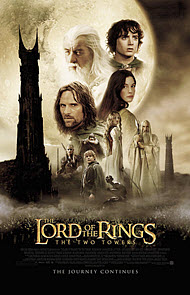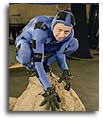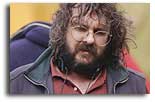The Lord of the Rings: The Two Towers
 for epic battle sequences and scary images.
for epic battle sequences and scary images.
Reviewed by: Ken James
CONTRIBUTOR
| Moral Rating: | Average |
| Moviemaking Quality: |
|
| Primary Audience: | 15 to Adult |
| Genre: | Fantasy Action Adventure Drama Adaptation |
| Length: | 2 hr. 59 min. |
| Year of Release: | 2002 |
| USA Release: |





What? Huh?
It’s easy to get lost in all the strange sounding names and places if you’re unfamiliar with “The Lord of the Rings”. This series of stories penned by Christian British author J.R.R. Tolkien was first published in 1954. Since then it has had a profound effect on generations of readers, defining for many the archetypal struggle between good and evil.
In it, we are introduced to many races: Hobbits or halflings (Bilbo, Frodo, Sam, Merry and Pippin), Wizards with great power (Gandalf, Saruman), wise and peaceful Elves (Legolas, Galadriel, Arwen), Humans (Aragorn, Eowyn, King Theoden), Dwarfs (Gimli), the fiercesome and evil Orcs, and others.
In this epic adventure, Frodo is entrusted with an ancient and most powerful ring (one that rules over all 20 rings originally forged) that the evil Sauron wants for himself. It was lost long ago. If Sauron can capture it, he can become an invincible ruler of all Middle Earth. Frodo must make his way to Mordor where he can cast the ring into a great chasm of fire, forever preventing Sauron from his wicked plan of domination. The entire fate of Middle Earth rests in the hands of a lowly Hobbit.
| Featuring |
|---|
| Elijah Wood, Sean Astin, Cate Blanchett, Orlando Bloom, Billy Boyd, Brad Dourif, Bernard Hill, Christopher Lee, Ian McKellen, Dominic Monaghan, Viggo Mortensen, Miranda Otto, John Rhys-Davies, Andy Serkis, Liv Tyler, Karl Urban, Hugo Weaving, David Werham |
| Director |
|
Peter Jackson |
| Producer |
| Barrie M. Osborne, Peter Jackson, Fran Walsh |
| Distributor |
Read and Listen to Our Cast and Crew Interviews
Awaken companions. Middle Earth awaits. The time for “The Two Towers” has come. The second film in the epic trilogy based on the writings of JRR Tolkien has opened to fans around the world.
This three-hour long story is darker than the first, devoid of the happy times of the Shire as Frodo (Elijah Wood) and Sam (Sean Astin) press on toward Mordor, now separated from the fellowship that set out from Rivendell. While the bearer of the ring continues in his journey, Aragorn the Human (Viggo Mortensen), Gimli the Dwarf (John Rhys-Davies) and Legolas the Elf (Orlando Bloom) track down Hobbits Merry (Dominic Monaghan) and Pippin (Billy Boyd) who were abducted by Orcs at the conclusion of “The Fellowship of the Ring” and are on their way to see Wizard Saruman (Christopher Lee).
 Several new characters are introduced in “The Two Towers”. Among them is the CG-based Gollum (voice and movement given by Andy Serkis, perhaps destined for an Oscar for “Best Supporting Actor”); Humans of Rohan King Theoden (Bernard Hill), his niece Eowyn (Miranda Otto) and Nephew Eomer (Karl Urban), the evil adviser Wormtongue (Brad Dourif), and others. The animated trees of the Fangorn Forest, led by the Ent Treebeard (voice by John Rhys-Davies), also come to wonderful life and play a big part in the assault upon Isengard.
Several new characters are introduced in “The Two Towers”. Among them is the CG-based Gollum (voice and movement given by Andy Serkis, perhaps destined for an Oscar for “Best Supporting Actor”); Humans of Rohan King Theoden (Bernard Hill), his niece Eowyn (Miranda Otto) and Nephew Eomer (Karl Urban), the evil adviser Wormtongue (Brad Dourif), and others. The animated trees of the Fangorn Forest, led by the Ent Treebeard (voice by John Rhys-Davies), also come to wonderful life and play a big part in the assault upon Isengard.
The heavy violence, use of wizardry, and frightening images (demonic in appearance) in “The Two Towers” are the most concerning elements. There is no sex or profanity. (Gollum isn’t wearing much, but he’s a CG character and doesn’t show anything.) Aragon shares a few more kisses with his love Arwen the Elf (Liv Tyler). Battle after battle ensue: the fierce Uruk-hai vs. the Riders of Rohan, Orc mounted upon Wargs (a mix of bear, wolf and hyena) vs. Rohan warriors again, and the MASSIVE** 10,000 strong army of Saruman vs. every man, woman and child of the Rohan Kingdom in the battle at Helm’s Deep.
More specifically, we witness one or two head dismemberments (though not particularly gory), a head impaled upon a stake as dead Orc bodies smolder, and a large number of sword fights and stabbings. But if the first film didn’t bother you, this one probably won’t either. That said, I don’t recommend this for those under fifteen.
 ** MASSIVE is the ground-breaking software that WETA Digital has developed that enables the CG Orcs numbering 10,000 strong to each independently choose from several offensive and defensive moves as they are engaged in battle. Each computerized warrior has its own brain, in essence. In an earlier version of MASSIVE, Producer Barrie Osborne told me of how about half of the Orcs that approached the enemy decided to run away as deserters rather than fight their opponent!
** MASSIVE is the ground-breaking software that WETA Digital has developed that enables the CG Orcs numbering 10,000 strong to each independently choose from several offensive and defensive moves as they are engaged in battle. Each computerized warrior has its own brain, in essence. In an earlier version of MASSIVE, Producer Barrie Osborne told me of how about half of the Orcs that approached the enemy decided to run away as deserters rather than fight their opponent!
The evil in “The Two Towers” can be quite frightening, seen personified in several characters: the Human Grima Wormtongue (and the bewitching he has done upon King Theoden as his trusted adviser), the beastly Orcs, and the dead spirits in the Dead Marshes that seek to make captive Frodo and Sam. The two towers are said to represent different kinds of evil: Barad-dur, fortress of the Dark Lord Sauron, sends out a dark mist of evil that pervades entire regions, whereas Orthanc, Saruman the White’s tower of Isengard (a sickening flattery of Barad-dur) represents a more personal evil. No matter what kind of evil it is, our unlikely heroes know that it must be fought.
Tolkien himself was anti-war, having fought in World War I and penning this story during the events of WWII. He faced horrible tragedy in the loss of his closest friends and saw firsthand the evil that exists in our world. A committed Christian and contemporary of CS Lewis who helped him along in his own pursuit of the Creator, Tolkien clearly denied that “The Lord of the Rings” is an allegory of the gospel. Yet there is much to glean from its pages.
The most positive elements include the bonds of friendship, the continual battle against evil, redemption of those who seem perhaps beyond hope (in Gollum), the choices one can make to choose the right, concern for the environment (with the substory surrounding the Ents, Keepers of the Forest), and one word: HOPE. There is always hope. Samwise Gamgee, Frodo’s faithful companion, becomes a narrator during this tale and offers profound thoughts, perhaps the chief of which is “there is some good in this world, and it’s worth fighting for.”
(For a more detailed look, we recommend Finding God in the Lord of the Rings by Kurt Bruner and Jim Ware).
I noted several spiritual themes in this story that are worth a closer look. Frodo and Sam find themselves disagreeing about Gollum and the role he should play in helping them. Can he be trusted? Frodo feels a certain bond to him, as they both share the experience of being a bearer of the great ring. Yet Sam believes Gollum will betray their trust and murder them in the night, stealing back “my precioussss.” Is one so foul in appearance beyond redemption? Surprisingly, you can’t help but begin to find a soft spot for the pitiful Gollum. And such an extension of grace and trust by Frodo begins to bring out schizophrenic episodes in Gollum as his darker self begins to argue with the goodness and innocence that tries to come to the surface. I found these scenes particularly interesting and clever; even humorous.
Those who know the story already will also know that Gandalf returns as an even more powerful figure. In a dream sequence Frodo has at the start of the story, we witness how Gandalf the Grey fought with the fiery demon Balrog as the two fell deep below the earth in the Mines of Moria. Gandalf eventually defeats his enemy, but lies near death until he is supernaturally revived and healed, sent back to Middle Earth to complete his task not yet finished. The parallels to Jesus’ defeat of Satan through his death, burial and resurrection can be recognized for those who look.
In one scene with spiritual warfare significance, Gandalf the White enters the oppressive darkness of the Court of Rohan where King Theoden is under the spell of the serpent-like Grima Wormtongue (a pawn of Saruman). He breaks the spell the King has been under, and with dazzling light a scene of exorcism takes place. The nearly-dead King is restored to health and vigor, able to see things for what they are and no longer willing to take the counsel of his once-trusted advisor.

When I spoke with Director/Producer/Writer Peter Jackson, affectionately known as “PJ” by the tight-knit cast and crew who describe him as a genius, he made it known that “The Two Towers” is simply the second act of the larger trilogy. It is really a 10-hour epic film, though released over a three-year period. There is no “when last we saw Frodo and Sam they were…” So if you’ve seen “Fellowship” and enjoyed it, I know you’ll love “The Two Towers”. If you’ve not seen the first movie, spend a few bucks and watch it before this one. You’ll be lost without, unless you’ve read the books.


[Good / 5]
The filmmaking is spectacular, the acting stellar, and the CGI-created characters (including Gollum) are incredible. I never once felt I was watching a computer-generated actor. But beyond that, the true worth lies in the spiritual parallels. Tolkien originally claimed not to have written the novels as an allegory, but admitted later in his life that “[they] are a profoundly religious and Catholic work… the religious element is absorbed into the story and symbolism.”
Thus said, “symbolism” abounds, some of it unabashedly blunt: such as the obvious Gandalf “Christ-figure” emphasis. There are parallels to the valley of death, the second coming of Christ, and the eternal message that hope will always prevail. Seeking for these parallels has become something of a passion for me. I encourage others to try it: you may be surprised at what you find.
[Good / 5]
[5]
Forgiveness and faith also are prevalent in the film. To be honest, I was worried about how the movie would portray Theoden’s exorcism by Gandalf, but the aspect of demonism was completely avoided, with the restoration being quiet and subtle. There was more violence and gore in this film, but like the first film, the orcs (goblins), felt the brunt of it. Wonderful, wonderful film. NOT FOR CHILDREN! :)
[Better than Average / 5]
I can see where children (and adults) could find this boring, but I wouldn’t have Jackson change this what so ever. The philosophy of the move is fantastic. The directer nearly got everything that Tolkien wants his readers to get. All but one, Jackson seems to always forget the whole idea of when hope is all gone there is always revenge. This is throughout all of Tolkien’s books. But, I guess we aren’t all perfect. But the movie was well made, and there was very little wrong with it. (Except Frodo in Gondor, that was weird).
I would suggest people from 10 and up to see this, and to have some good conversations with their parents, and friends. I know I had some good discussions with my friends when it was done. It is very refreshing to see Movies doing this again. I cannot wait to see the wonder of Return of the King.
[Better than Average / 5]
[Average / 4½]
[Good / 5]
[Better than Average / 5]
The story seems slightly less steady than during the first third, but memorable scenes, witty characters, and meaningful realizations within the story make this part no less effective than the first. The acting and music are just as powerful as before, and new hummable themes are used for new characters and places. The speaking trees and Ents are both amusing wise and their interactions with the hobbits are thoughtful as they seem to live as observers and messengers in Middle Earth.See all »
Moral rating: Average / Moviemaking quality: 4½
Unfortunately, for those of us who have read the book, it is simply impossible to live up to them and include everything. Aside from Gollum (Smeagol), the new characters are not developed well, mainly to stay under the three-hour mark. Gollum’s character, however, is done superbly and is the most memorable in the film. Each book warrants a film twice as long as what we are given, but nobody would sit through a six-hour movie. The film does stray from the text at some points, which is to be expected.See all »
[Better than Average / 5]
As for the depiction of the enemy, it can become quite disturbing (eg. some of the bad guys look like they’re decomposing and others just truly look like big, ugly embodiments of evil.) As for any biblical parallels in this movie (other than good vs. bad and the hope/faith vs. hopelessness), the one that seemed most apparent to me was the character Smeagal (Gollum?).See all »
[Average / 5]
I disliked the Ents—I felt they could have been done better, and the depiction of Treebeard was all wrong (hasty, yes, terribly sorry, hoom hom). I thought the voiceover by Galadriel was rather goofy, and I would have cut out half of the scenes with Arwen. No, not just because they lacked sword-play! Alright, maybe mainly because they lacked sword play…
Now, negative words aside: my wait was not disappointed. After the awful previews bore themselves out (as an infrequent movie-goer, I forget the stupidity UnHolywood produces), we sweep into Middle Earth and are soon treated to an incredible sequence of Gandalf and the Balrog’s fight deep within the earth. Magnificant! Whirring on we get our first look at Gollum: and Gollum, or Smeagol, is, I think, the finest character of the film.
Here’s hoping Andy Serkis gets his hands on a little gold man this year. His depiction of Gollum was remarkably moving and real—and very, very much like the book, which of course made me happy. Rohan was wonderful, and Eowyn was a sterling character. Her nobility and beauty—and the sadness woven about her—came off excellently. Wormtongue and Theoden were great, though I thought the “exorcism” of Theoden rather odd: wasn’t expecting that. Theoden’s recital of verse was grand—very Rohanish.
The Battle of Helm’s Deep: Ai! Ai! I cried out with Gimli and held score. All in all a great film, free from the sex, profanity, and crudities so typical in film. And the violence, while tense, could have been far worse: as in Fellowship, camera movement is swift and blood is surprisingly in little evidence. Considering the gore that goes with medieval-style warfare, we were spared.
The orcs are nasty, and the Nazgul (how bout them foul dwimmerliks they were on?) and Dead of the Marshes are terrifying of course, although I noticed more humaness this time—note the orcs are quite cognent. There is much for the Christian to take from Middle Earth, but I don’t have time to go into it: and I haven’t really examined the film, considering it differs substantially from the book.
Younger children would likely be frightened by the orcs and Nazgul and such, but for everyone else, this is a fine epic adventure, except for some hardcore Tolkien purists. (I am still wondering how Frodo got back over the Anduin after his detour with Faramir…)
[Better than Average / 5]
[Better than Average / 5]
As for objectionable material, the fighting is intense and slightly gory; the sight of Orcs being impaled and men being slain is hard to grasp at a young age. I’d suggest 12 and over. Other than the fighting, which is a fact of life, this movie is the most powerful and deepest created yet. And kudos for Gollum! He was the star of the show! Absolutely spectacular!
[Good / 5]
The music inspires the same feelings I had when reading the book. It IS the music for Middle Earth. The theme for Rohan was the highlight of the score. It was really simple, and yet it seemed to fit every time they used it. It almost made me feel patriotic… Brad Dourif’s performace was the best of the new characters. He did an excellent job portraying the evilness, and the humanity about him. It’s refreshing to see villains who are evil (like Saruman and Wormtongue) and are not encouraged to be liked by the audience, so you really DO hope the heroes win. A really interesting villain. Karl Urban (Eomer) and Bernard Hill (King Theoden) also turned in good and memorable performances.
Gimli develops more and more as we watch him. Though he was the only comic relief throughout the film, he is utterly hilarious, so I forgive him. There are some interesting scenes between Elrond and Arwen… very thought provoking, and very sweet. Meanwhile, Frodo and Sam meet Gollum on their way to Mordor.
Gollum is absolutely seamless, nothing was fake about him. The CGI was totally convincing. They did an excellent job portraying his conflicting sides… Now the bad: I personally liked “The Fellowship Of The Ring” better because it seemed to stay truer to the spirit of Tolkien. The pacing for “Two Towers” was too fast. It really distracted you from what was trying to be said.
The violence was more heavy, more brutal, and there was way more of it. The score (though it carried the film well) lacked a lot of new material (aside from the Rohan theme). The last march of the Ents was a little less spectacular then I imagined, and the battle for Helms Deep was way too spectacular. It wasn’t that big in the book. The film really overdid it.
Plus, there was a surprising lack of Saruman, which is sorely missed, since it seems the only villains are mindless Uruk Hai. That pretty much sums it up. It was a wonderful film, second only to the Fellowship. The Catholic world view of Tolkien shows in his works, and they did a fair job incorporating that into the films. The magic and wizardry is not realistic, and is almost metaphorical in a sense, of spiritual warfare.
Congrats to Peter Jackson! May thy films ever be good. GO SEE THIS MOVIE, AND BUY THE DVD! Hooray for “The Lord Of The Rings”!
[Better than Average / 5]
[Better than Average / 5]
[Good / 5]
Yes, the orcs are ugly, but so is evil. There is no gore and no profuse bleeding. There are a few kisses between Aragorn and Arwen, but they don’t have the “juicyness” of Star Wars Episode II. If I recall correctly, in most cases it showed them starting and went into a view that was farther away and/or not as “personal.”
I think that these scenes with Arwen were necessary to show that Aragorn was being faithful to Arwen and not falling in love with Eowyn, who was giving him some looks. There is much humor to lighten up the darkness of this film. Legolas was cool, as was Gimli. I won’t ruin the special effects in trying to describe them. A must see film!!
[Excellent! / 5]
[Good / 5]
There was about a 1 and ½ hour battle scene in the movie, which seemed to drag out forever. What do you expect when you are fighting off 10,000 orcs though?! Romance and comedy appear throughout the story, which makes it more enjoyable for different sorts of audiences. More gory than the 1st, be prepared. Nothing that will give you nightmares or anything like that is affiliated though, if you are above the age of eleven. I highly recommend this for anyone who is in search of adventure and action!
[Good / 5]
1. The violence is sometimes quite heavy, so watch out for the younger children. They WILL get scared—especially of Gollum. and…
2. There is a slight “passionate kiss” in the movie. It is between Aragorn and Arwen. But, it is JUST a kiss—nothing else. It just is a little bit prolonged, but it is nothing too graphic and all ages should be able to few it… Knowing that, it’s an AWESOME, AWESOME MOVIE!!! Go see it!
[Good / 5]
[Average / 3½]
Also, Gandalf is not a Christ-figure. I don’t know if his “resurrection” is meant to mirror that or not. Aragorn is the Christ-figure. He is the son of the king who laid aside his glory until it was time to reclaim it. In the meantime, he takes on the role of humble servant and healer.
I believe Gandalf was modeled off of the Old Testament Valar. In any case, these books were the best I’ve ever read. When I have seen the second film I will probably have some comments to make, especially on the changes “PJ” makes.

The special effects were great. The movie is very violent and parents should use discretion when allowing children to view this movie. I liked the way evil was portrayed by its ugly appearance in the Orcs, Uruk-Hai, Wormtongue, and Gollum. This was unrealistic yet refreshing. The serpent in the Garden was quite beautiful as I recall.
Wouldn’t it be wonderful if we could spot evil so easily in our lives? The war between good and evil at Helms Deep was impressive and inspiring. Churchill said nothing is as exhilerating as being shot at without effect. I felt this through the triumph of Aragorn in the great battle. Gandalf assumes even a more powerful and angelic role than in the Fellowship. Whether this is suppose to be Christian imagery or not I do not know. Nevertheless, it certainly made me think of the spiritual realm.
My Ratings: [Average / 5]